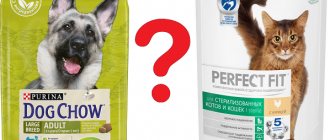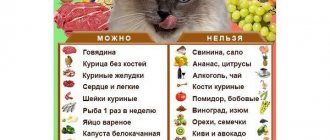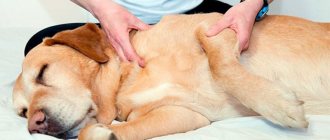Why does a dog chew bones?
Experienced owners know that even a well-fed dog will never refuse a tasty bone. Thus, hunger has nothing to do with the tailed pets’ love for bones. Note that this product contains a lot of calcium, but little organic substances.
Historically, almost 8 million years ago, canines hunted in packs, which made it possible to obtain abundant prey. The meat of wild animals developed the jaw apparatus of dogs, making the teeth sharper and larger, and the jaws more powerful in the process of evolution. The bones acted as a toothbrush, helping to free the mouth from stuck pieces of food. In addition, when chewing coarse solid food, the gums were massaged and the jaw was trained.
Nowadays, bones are needed by dogs for the same purpose. In addition, dogs perceive such a treat as a kind of trophy that they can play with or leave for later, so that it acquires a smell that is pleasant to the animal’s nose.
The dog's body perfectly digests bone remains, obtaining calcium and additional substances from them. Calcium is supplied mainly in the animal's fur.
If an animal’s diet contains a lot of this component, its skin becomes tougher, shiny and prickly to the touch. When changing the diet towards a decrease in quantity, it becomes more elastic. Balance and dosage are important.
A dog with a bone in its teeth is a dangerous stereotype
Dogs love bones, cats love milk and fish - these are stereotypes imposed on every person since childhood. Fairy tales, cartoons, stories lay an unshakable truth in our minds. That is why it never occurs to the adult owner of a tailed friend that bones can kill the pet or significantly shorten its life. We invite you to debunk the main clichés associated with the appropriateness of bones in a dog’s diet:
- The pet should receive solid food every day, because this is how wild dogs live - solid food, perhaps, but not bones, but raw vegetables and fruits. For reference: wild and stray animals rarely live past 8 years of age, since they lose their teeth early and begin to experience digestive difficulties. If you feed your dog industrial food, feeding “dangerous treats” is not at all appropriate.
- A dog needs bones to sharpen its teeth - mammals replace baby teeth with molars. Dogs' teeth do not grow and become dull with age. But a dog doesn’t sharpen its teeth with bones, it grinds them down, scratches the enamel and risks breaking its fangs or incisors!
Are bones beneficial or harmful?
Disputes about the benefits or harms of a product do not subside; supporters of one point of view or another provide many arguments. Let's highlight the pros and cons of the presence of bones in feeding a dog:
| Benefit | Harm |
|
|
All of these consequences are the result of improperly selected bones or too frequent introduction of them into the diet. For an adult dog, it is enough to feed raw food 1 or 2 times a week.
If a dog is pursuing a show career, bones are strictly contraindicated. There may be a change in the bite or appearance of the teeth.
What bones can you feed your pet?
- veal. Small, smooth, spongy ones that do not have sharp edges are suitable. Can be chopped so the dog can gnaw out the core. Cartilaginous veal ribs, which the dog can eat completely, are perfect for treats;
- poultry - you can use chicken heads, having previously trimmed the beak so as not to injure the mouth and internal organs.
The product is only available in raw form. The age of the killed animal matters, this mainly applies to cows - in the spongy substance of the skeleton, with age, many harmful substances accumulate that are harmful to the dog’s body.
What bones should you not feed your dog?
- raw poultry - when eaten, they tend to crumble, forming many sharp fragments that can cause serious injury and clog the stomach. In addition, without heat treatment, chicken bones are a source of infection and inflammation. They contain dangerous bacteria that begin to multiply in the acidic environment of the dog’s stomach;
- boiled - few useful substances; heat treatment produces gluten. Such bones are softer than raw ones and do not form such sharp fragments, but in the stomach they form a dense lump that is difficult to remove from the body;
- raw pork - there is a danger of infecting the dog with helminths, the meat is too fatty;
- rabbit – too small, form sharp parts;
- fish – even the smallest fish bones can lead to the need for surgery. They are carefully chosen.
You cannot give the above types, but you can cook broth with them and add it to the cereals, separate the cartilage, and throw out the rest.
If the dog is fed dry food or is on a mixed diet, bone products should not be given. These dogs have altered stomach acidity and will find it difficult to digest the product.
Absolutely no feeding
There are several types of bones that should never be given to dogs if you want the best for your pet. Including such popular pork bones - pork has a high fat content and can be infected with parasites.
Tubular chicken
Tubular bones pose a huge danger to dogs. Let's find out why.
We recommend this article:
What foods can and cannot be fed to your dog?
When an animal chews a bone, it crumbles into small fragments with sharp edges that can injure the walls of the stomach or intestines, in some cases causing peritonitis. In this case, only surgical intervention can save the situation, and a positive result is not always likely.
Of course, don't panic if your dog accidentally eats a chicken bone once - most likely, it won't cause him much harm. But feeding such “treats” to your pet on a regular basis is categorically not recommended.
Turkey bones
Turkey bones are no less (if not more) dangerous than chicken bones: they have a similar structure, but are much harder. The fact is that this bird is slaughtered when it reaches two or three years of age, so the skeleton has time to become significantly stronger. In addition, the turkey is a fairly large bird, so its bones themselves are much larger.
Gusin
The story is similar with goose bones - they are large and hard, so they can significantly injure the animal’s mouth and intestines, causing serious health problems.
We recommend this article:
Why dogs can’t have sweets and is this really true?
Rabbit bones
Some dog breeders are not afraid to give their pets rabbit bones, believing that since they are small, they are not dangerous. In fact, a broken rib bone, spine or limb has extremely sharp edges.
Consequences of eating bones
Under no circumstances should you give bones daily. Optimally – once or twice a week, in small quantities. You must be prepared for complications, even if you follow all the rules:
- poisoning. The raw product may accumulate pathogenic flora, toxins and bacteria. It is important to purchase meat products from a trusted seller;
- thinning and damage to tooth enamel;
- injuries to the mucous membrane of the mouth;
- disruption of the gastrointestinal tract: constipation, diarrhea, indigestion;
- vomiting due to parts getting stuck in the stomach;
- fragments getting stuck in the throat, which can lead to suffocation.
At the first sign of illness, if it is a consequence of eating bones, contact your veterinarian immediately. In some cases, immediate surgical intervention is required.
Should you give bones to your dog or not?
After reading, each owner of a four-legged pet will decide for himself whether he can give his dog bones. It is important to remember that they are not natural food for dogs, nor are they food in general. They are not digested and are not completely eliminated by the body. If your pet suffers from bad teeth, gastrointestinal problems, or a weak immune system, bones can make the situation worse. They tend to accumulate in the stomach and intestines, causing partial obstruction. In this case, it is possible to help the dog only by resorting to surgical intervention.
Today there are many alternative animal products - dried veins, pig ears, beef lips, pressed bones, etc. They satisfy the dog’s need to chew and serve as a preventative against plaque and tartar. They can be given to your pet as entertainment or reward without fear for his health.
How to choose a chewing bone?
Even a properly chosen meat and bone product can lead to unpleasant consequences; many owners refuse to give it to dogs, depriving them of a tasty treat and an additional source of nutrients. You should not deny your pet such a treat; there is an opportunity to choose chewing bones sold in specialized stores.
They contain: rawhide or starch base, vitamins and minerals, useful substances. Such a delicacy toy will completely satisfy the need for chewing rough food, clean the mouth, massage the gums and will not cause harm. When choosing a delicacy similar to natural, consider:
- dog size. Treats that are too small can get stuck in the throat and cause choking and suffocation. You should not give a huge treat to a large dog; a medium size will do;
- taste - they focus on the preferences of the pet itself, giving several types;
- texture: hard, soft, special chewy. Focus on the animal’s age, dental condition and preferences;
- additives: calcium, from tendons (for allergy sufferers), gelatin (source of collagen, vitamins, suitable for pregnant bitches), chicken (complete analogue without unpleasant consequences).
Do not leave your puppy alone with such a tasty treat - his jaws are still poorly developed and will not be able to cope with the product.
FAQ
At what age can a puppy be given bones?
It can be introduced into the diet of babies from 3-4 months. The puppy is monitored while eating, never left alone. The product is chosen in such a size that it is not possible to chew it completely. After the puppy gnaws the meat and cartilage from the bone, it is taken away.
Do bones wear down dogs' teeth?
Yes, they are erased. Rodents, not dogs, grow teeth throughout their lives. Therefore, such a component should not be given too often, and “bare bones” should not be used.
What to do if your dog is constipated after eating bones?
If the stool has acquired a whitish tint interspersed with residues, the frequency of dispensing the product should be reduced. For constipation, Vaseline oil is given to facilitate bowel movements. For prolonged constipation, consult a veterinarian.
What to do if a dog chokes on a bone?
You should calm the dog down, examine the mouth and try to remove the stuck foreign object. Don't panic. Remove the fragment carefully, trying not to cause further injury. Contact a veterinarian for additional examination.
Are bones digested in a dog's stomach?
The acidity of a dog's stomach is higher than that of a human, which allows the bones to be completely digested.
How often can you give bones to your dog?
Raw beef bones should be given to your tailed pet no more than twice a week, doing this either with the main portion of food or after.
Feed your dog bones? Get ready for trouble!
You decided to give your dog raw bones, contrary to all prohibitions, for example, based on your grandfather’s experience, whose whole life Sharik ate only chicken bones and lived to be 15 years old. Well, it's up to you, but with a possible list of consequences
We recommend that you read:
- Throat injuries
- by swallowing bone fragments, a dog can not only scratch the mucous membranes, but also pierce them. There are many vessels in the area of the vocal cords, damage to which will lead to severe bleeding. Tracheal injury is also fatal. Usually, if a dog has injured its throat or trachea, there is no time to take it to the hospital, the animal either dies from blood loss or chokes in it.
- Asphyxia
is an equally common cause of death in animals. Usually, if a bone gets stuck in the gaps of the chewing teeth, the dog begins to choke on its own saliva. Without timely help, the dog dies from suffocation. A very popular outcome is if the pet is fed the spines of a large bird.
- Constant vomiting and, as a result, dehydration and a threat to life
- this usually happens if a dog swallows a large bone and it gets stuck in the stomach. The body's natural reaction is to vomit, but the bone does not come out with the vomit. The situation can only be resolved operationally.
- Accumulation of bones in the stomach
- a case similar to that described above, but involves clogging of the stomach with small bones and their fragments. Most stray dogs die from this disease. Disturbed metabolism associated with prolonged poor nutrition leads to a decrease in the acidity of gastric juice. As a result, the bones do not soften and do not pass into the intestines, but accumulate, forming a “clump of needles.” The animal dies from obstruction or bleeding. The condition is treated surgically.
There is a stereotype that dogs love to chew bones, but you can argue with that. Many dog lovers will confidently say that bones are beneficial for the animal. It's worth looking into this issue.
Briefly about the main thing
- Bones are a necessary component of an animal’s diet;
- Beef is given raw at the rate of approximately 20% of the meat component of the serving;
- The frequency with which treats should be given is no more than twice a week;
- You cannot give poultry, rabbit, lamb and fish;
- Dry, whitish stools and problems with bowel movements indicate the need to reduce the amount of food consumed;
- The mouth requires special care - inspection of the mucous membrane after consumption;
- It is permissible to introduce it into the diet only when feeding the dog natural food;
- Puppies are given treats starting from 3-4 months;
- It is possible to replace natural bones with specialized industrial treats;
- If you feel unwell as a result of eating bones, you should contact your veterinarian.
Do your dogs love to chew sugar bones? How often do you give them to dogs? What do you think is better: raw natural or industrial bone treats? Tell us about your experience in the comments, please!











